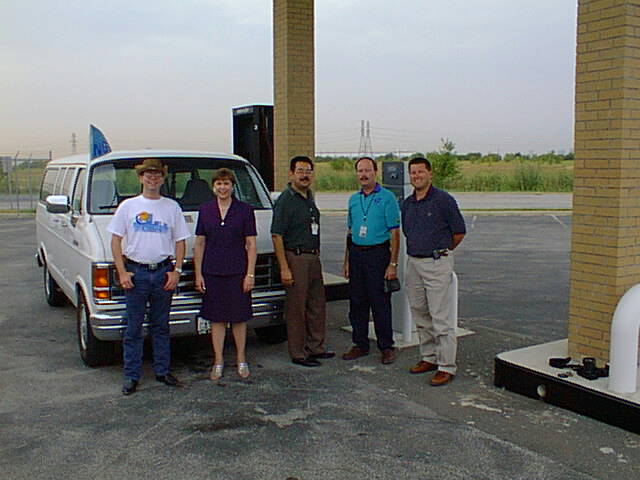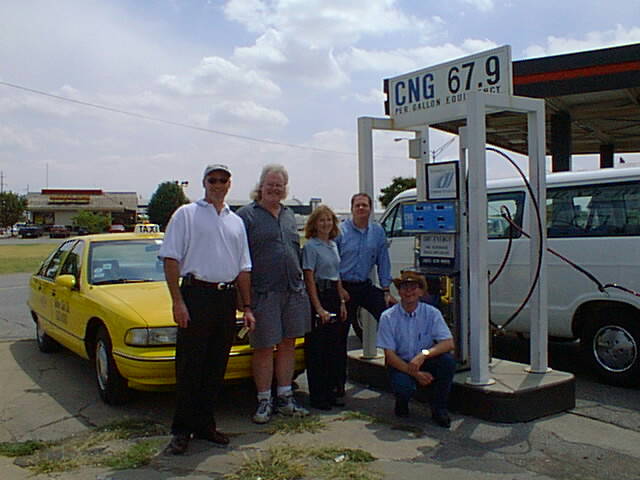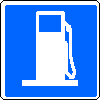
Home - Clean & Back - Day 4
Back to optimism! When last we left our hero, he had run out of fuel at a Fina/FleetStar station in south Ft. Worth, TX. This morning I made a call to Belinda Garza of the North Central Texas Council of Governments, and Jose Rodriguez and Stuart Pingelton of the United States Postal Service came riding like the cavalry over the hill (in a Ford Bronco) to take me back to where I had left my van, and we met Lorenzo Gonzales (also of USPS) there with a working fuelcard. Fifteen minutes later we were all back on the road, and I ended up at the scheduled stop only about forty minutes later than planned. Thanks for getting me back on track!
The reason the USPS got dragged into my little difficulty was that the scheduled refueling stop was at a station next to the Jack Watson USPS facility. The Postal Service fleet is one of the largest single users of alternative motor vehicle fuels in the country, and it's an excellent example of the government "seeding" the alternative-fuels market with its immense buying power. The market, both for vehicles and for fuels, gets built, and the government gets vehicles with both environmental and economic advantages (as I've argued elsewhere on this website); clearly a win-win situation, and the kind of thing the Clean Cities program was set up to encourage.

This is most of the group that gathered there; unfortunately, I didn't get to meet some of the people who had come from the General Services Administration because they had to leave before my delayed arrival. From left to right, that's me (in the Clean Cities T-shirt), Nan Miller of the North Central Texas Council of Gov'ts. (the Dallas-Ft. Worth Clean Cities Coordinator, who set up this visit), Jose Rodriguez and Stuart Pingelton of the USPS (who got me restarted that morning), and Barry White of Lone Star Energy Company (who supply the CNG fuel). Thanks to all of you, and to the others who were there! They presented me with a Clean Cities/Chrysler Corp. canvas bag containing some Clean Cities items and some local Dallas/Ft. Worth products. As I promised them, I didn't open the Miller Lite until I was done driving for the day (these hotel ice buckets work fine to chill the summer heat out of the bottles, as one does with champagne), and the beans will have to wait until I get back to my stove at the apartment, but I put a big dent in the Tostitos and salsa by the time I reached Oklahoma City! I'm the kind of driver who gets "in the groove" and refuses to stop for a sit-down meal...
I hope that you have heard from me about range, margins, headwinds, and the like for the last time in this journey; from Ft. Worth on out, there are no further scheduled drives between refueling stations of anything near 300 miles, so I shouldn't have to stretch range so desperately any more. The next two legs of the trip were quite enjoyable, with reasonable speeds and air conditioner if I needed it, so that I could relax and enjoy the scenery. My Dad was born in Stillwater, OK (near Tulsa), and I have lots of memories from my childhood of driving from Missouri to visit his mother there. I particularly remember riding in the back seat of a 1970 Plymouth station wagon bigger than my van, looking up at stars in a sky darker than we ever saw in suburban St. Charles, MO. I also remember the red, iron-rich earth, which I have always associated with Oklahoma; driving north from Ft. Worth, I realized that it went well south into Texas. There's a reason that the river on the wiggly part of the Texas/Oklahoma border is called the Red River--red silt, and plenty of it.

At the refueling stop in Oklahoma City, we were all surprised by an unexpected attendee of the gathering: Earl Gepner, an independent contractor with the Yellow Cab Company, who pulled up to the compressed-natural-gas dispenser to refuel his taxi, which was an early-1990's Chevrolet Caprice converted to a bi-fuel CNG vehicle. The folks from the local Clean Cities Coalition didn't know he had one; nobody gave him any "push" to get it--he just looked at the fuel price at the stations (67.9 cents per gallon-equivalent for CNG, vs. 86.9 cents (in the middle of a price war, I'm told) for the cheapest gasoline I saw in the area) and decided it made economic sense. The Clean Cities folks were elated to run into him, and so was I; after all, my van is a private vehicle, and it's easy to dismiss as an eccentric's hobby, but Mr. Gepner has to make a living in the real world with his vehicle--his success is a better argument for the economic viability of alternative fuels than all the theorizing on this website!

Here's a group portrait--I promised to post a big one so they could download it, because I was the only one who had brought a camera... Left to right in front of the taxi and my van are Bo Harrison of Oklahoma Natural Gas, Earl Gepner, Sheri Vanhooser and Patrick Brown of DRV Energy (a vehicle convertor and refueling-station builder), and me; behind the camera is Jennifer James of the Central Oklahoma Clean Cities Coalition, who organized the stop. Bo Harrison also offered to link me up with a colleague in Chicago, who could help me refuel in the vicinity so I don't have to drive straight through from Albion, MI to Milwaukee, WI in a couple of weeks. Thanks to all of you!
The next leg of the trip was a short one, 110 miles up the turnpike with the land gradually flattening out from the rolling hills farther south, to a Fuelman automated refueling station in Tulsa. Unfortunately, Nancy Graham of the Indian Nations Council of Gov'ts. (and Coordinator for the Tulsa Clean Cities Coalition), who set up this stop, was out sick today, so I didn't get to meet her; she stayed late yesterday trying to nail down exactly which station we could use, so I hope I didn't contribute to her getting sick (get well soon!). Her colleagues Gaylon Pinc and Richard Smith met me at the station, along with Jeff Beach of Fuelman and John Kiska of Oklahoma Natural Gas (Richard Smith had a camera and shot a lot of pictures, so I left that to him).
Fuelman, like FleetStar, runs unattended refueling facilities with fuel-card access, while my Oklahoma City stop was at a Phillips 66 station that will sell you CNG for cash. Because my experience is almost entirely with fuel-card stations, I have been surprised at how many stations there are that will actually accept cash or credit cards; again, though, if you are in the service territory of FleetStar or Fuelman, my experience has been that such companies are more than happy to deal with individual CNG users as well as their usual fleet customers.
Because I couldn't get a room in Tulsa three weeks ago (we discussed it while I was refueling there, and we think it's due to a girls' softball tournament that's in town), I drove further up the turnpike to Miami, OK (pronounced MiamUH rather than MiamEE as in Florida--it's like my home state, which is MissourEE to folks within the sphere of influence of St. Louis, and MissourUH to everybody else in the state), where I'm spending the night. It's later than I had planned to turn in, but I wanted to catch the diary up to date; anyway, I'll hit the road later tomorrow by a couple of hours than I have been, since I only have to drive up from Miami, not Tulsa, to my next stop in Springfield, MO. Tomorrow night I'll be home again in St. Charles, MO!
 To
Day 5
To
Day 5 Back
to "Clean Across America And Back"
Back
to "Clean Across America And Back" Back
to Fueling Station
Back
to Fueling Station Site
Map
Site
Map Contact
Me
Contact
Me All content copyright 1998-2024 by Mark Looper, except as noted. Reuse of my copyrighted material is authorized under Creative Commons Attribution 4.0 International license (CC BY 4.0).
![]()
![]()
new 5 August 1998, revised 18 August 1998